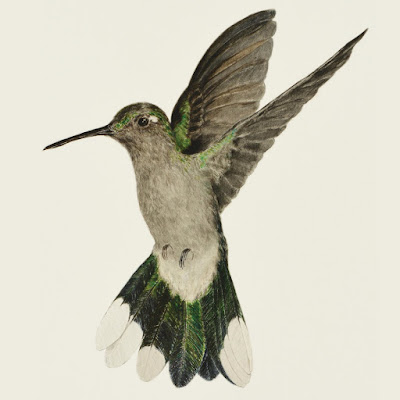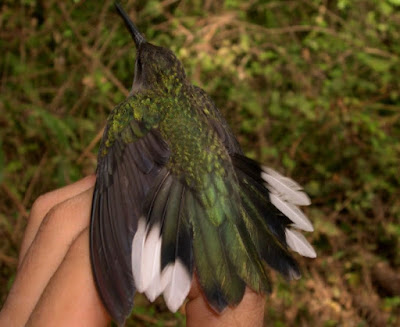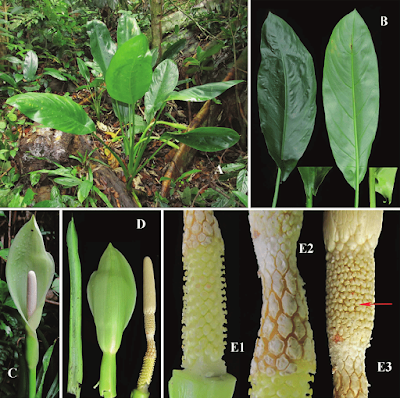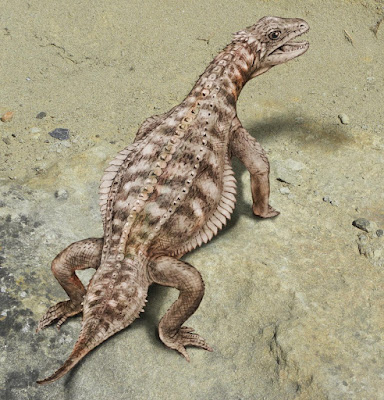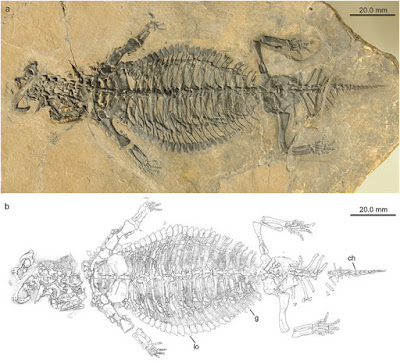[Most Recent Entries] [Calendar View]
Saturday, July 1st, 2017
| Time | Event | ||||
| 6:43a | [Ornithology • 2017] Campylopterus calcirupicola • A Cryptic New Species of Hummingbird of the Campylopterus largipennis complex (Aves: Trochilidae)
Abstract A new species of Campylopterus sabrewing is described from eastern Brazilian tropical dry forests occurring below 900 m asl. Its holotype (MZUSP 99024) is an adult female from Sítio Duboca (16°43’19’’S, 43°58’20’’W, elevation 840 m), municipality of Montes Claros, state of Minas Gerais. A taxonomic revision based on more than 1,000 museum specimens revealed that the new taxon, together with C. largipennis, C. diamantinensis and C. obscurus (with C. aequatorialis considered as a subjective junior synonym) should be ranked as species. We provide a key to permit easy identification of the four species. The new species is very similar to the parapatric C. diamantinensis of high altitude “campos rupestres” above 1,000 m asl, differing from it by its smaller size and longer light tail tips, as well as by sternum measurements. Given the several threats faced by the habitat to which the new species is endemic, we propose to consider it as Vulnerable under the IUCN criteria. Keywords: cryptic biodiversity, Neotropical, Trochilidae, tropical dry forests, Aves
Campylopterus calcirupicola sp. nov. Dry-forest Sabrewing (English) Asa-de-sabre-da-mata-seca (Portuguese) Etymology. The name calcirupicola is Latin, composed by “calx”, calcis, limestone; “rupes”, steep rocks; and “cola”, dwelling (Eggli & Newton 2004). It refers to the habitat of this new hummingbird, which inhabits dry forests growing on limestone outcrops. This specific name matches that for the cactus Cereus calcirupicola F. Ritter, found in the type locality and in the same habitat (Ritter 1979) of the new hummingbird. The vernacular names we propose also refer to the habitat used by the new species. Geographic distribution. Campylopterus calcirupicola has been recorded from Divinópolis de Goiás (northeastern state of Goiás) and Coribe (southwestern state of Bahia) to Bocaiúva (northern state of Minas Gerais) on both banks of the São Francisco River, as well as in the Paranã River valley, an important tributary of the Tocantins River, west of the Serra Geral (Figures 9 and 10). The altitudinal range of this new species is between 460–880 m asl. The range of C. calcirupicola probably extends to southeastern Tocantins (Dornas et al. 2014) and the southern part of the state of Piauí (Santos 2004), from where there are sight records of C. largipennis. We believe that the specimen of C. largipennis from “Posse, Goiás” cited by Silva (1990) as housed in the MNRJ refers to the specimen from “Galheiros” housed in the same institution and mentioned by Ruschi (1951), probably representing a toponymic mistake committed by Silva (1990). Leonardo E. Lopes, Marcelo F. De Vasconcelos and Luiz P. Gonzaga. 2017. A Cryptic New Species of Hummingbird of the Campylopterus largipennis complex (Aves: Trochilidae). Zootaxa. 4268(1); 1–33. DOI: 10.11646/zootaxa.4268.1.1 CONHEÇA CARAMUJO E BEIJA-FLOR DESCOBERTOS POR CIENTISTAS DE MINAS | ||||
| 2:44p | [Botany • 2017] Vietnamocasia dauae • A New Genus from Central Vietnam belonging to the Alocasia-Colocasia clade (Araceae)
Abstract Vietnamocasia, a new monotypic aroid genus in the Alocasia-Colocasia clade, is described with the type species, Vietnamocasia dauae. Vietnamocasia is distinguished by possessing free individual staminate flowers, lacking expanded synconnectives, and having nodding inflorescences. Vegetatively Vietnamocasia is reminiscent of species of the distantly closely related Alocasia Cuprea Group, although Vietnamocasia is so far only known from the type locality in Central Vietnam, over 1200 km NE from the nearest representative of the Alocasia Cuprea Group. The phylogenetic analyses of Vietnamocasia dauae together with representative taxa from all genera of the Alocasia-Colocasia clade recovered Vietnamocasia as a strongly supported clade sister to Alocasia, together nested in a clade to which Leucocasia is a sister taxon. Vietnamocasia dauae is illustrated from living plants and with a line drawing. A key to all genera of Alocasia-Colocasia clade is included. Keywords: Endemics, Indochina, Malesia, phylogeny, Vietnamocasia dauae, Monocots Vietnamocasia N.S.Lý, S.Y.Wong & P.C.Boyce, gen. nov. Type: Vietnamocasia dauae N.S.Lý, S. Y. Wong, T.Haevermans & D.V.Nguyen, sp. nov. Etymology:— Vietnamocasia is compounded from the Greek classical name kolokasia, itself from an old Middle Eastern name qolqas (Nicolson 1987) and the root of Alocasia and Leucocasia (and the more distantly related Colocasia) + Vietnam. Distribution:— Vietnamocasia is so far known only from the type locality and its vicinity. Ecology:— At Mount Dầu Vietnamocasia dauae grows in moist shady understory of hillsides in secondary broadleaved forest dominated by dipterocarps at 150–490 m elevation. At the other known locality, Cà Đam, it occurs in primary evergreen broad-leaf forest at about 790 m elevation. Vietnamocasia dauae N. S. Lý, T. Haevermans, Y. S. Wong & D. V. Nguyen, sp. nov. Etymology:— The specific epithet is for Mount Dầu, the type locality, treated as feminine. Lý Ngọc-Sâm, Wong Sin Yeng, Thomas Haevermans, Nguyễn Văn Dư and PETER C. Boyce. 2017. Vietnamocasia, A New Genus from Central Vietnam belonging to the Alocasia-Colocasia clade (Araceae). Phytotaxa. 303(3); 253–263. DOI: 10.11646/phytotaxa.303.3.5 | ||||
| 2:53p | [Paleontology • 2017] A New, Exceptionally Preserved Juvenile Specimen of Eusaurosphargis dalsassoi (Diapsida) and Implications for Mesozoic Marine Diapsid Phylogeny
Abstract Recently it was suggested that the phylogenetic clustering of Mesozoic marine reptile lineages, such as thalattosaurs, the very successful fish-shaped ichthyosaurs and sauropterygians (including plesiosaurs), among others, in a so-called ‘superclade’ is an artefact linked to convergent evolution of morphological characters associated with a shared marine lifestyle. Accordingly, partial ‘un-scoring’ of the problematic phylogenetic characters was proposed. Here we report a new, exceptionally preserved and mostly articulated juvenile skeleton of the diapsid reptile, Eusaurosphargis dalsassoi, a species previously recovered within the marine reptile ‘superclade’, for which we now provide a revised diagnosis. Using micro-computed tomography, we show that besides having a deep skull with a short and broad rostrum, the most outstanding feature of the new specimen is extensive, complex body armour, mostly preserved in situ, along its vertebrae, ribs, and forelimbs, as well as a row of flat, keeled ventrolateral osteoderms associated with the gastralia. As a whole, the anatomical features support an essentially terrestrial lifestyle of the animal. A review of the proposed partial character ‘un-scoring’ using three published data matrices indicate that this approach is flawed and should be avoided, and that within the marine reptile ‘superclade’ E. dalsassoi potentially is the sister taxon of Sauropterygia.
Systematic Palaeontology Diapsida Osborn, 190321. Eusaurosphargis dalsassoi Nosotti and Rieppel, 2003. Holotype: BES SC 390 (Palaeontological Collection of the Museo Civico di Storia Naturale di Milano, Italy), an associated but disarticulated specimen from the Besano Formation (242 Ma, Anisian-Ladinian, Middle Triassic) of Besano, Lombardy, Italy. Referred specimen: PIMUZ A/III 4380, an almost completely articulated skeleton preserved in ventral view (Fig. 2a). Stratigraphy and locality: Upper Prosanto Formation (bed no. 1; fossil found on bottom side of a limestone slab); 241 Ma, early Ladinian, Middle Triassic of Ducanfurgga locality no. 4, south of Davos, Canton Grisons (Graubünden), south-eastern Switzerland.   Torsten M. Scheyer, James M. Neenan, Timea Bodogan, Heinz Furrer, Christian Obrist and Mathieu Plamondon. 2017. A New, Exceptionally Preserved Juvenile Specimen of Eusaurosphargis dalsassoi (Diapsida) and Implications for Mesozoic Marine Diapsid Phylogeny. Scientific Reports. 7, 4406. DOI: 10.1038/s41598-017-04514-x Rare, exceptionally preserved fossil reveals lifestyle of ancient armor-plated reptile phy.so/418006972 @physorg_com Davoser Saurier zeigt erstmals seine bizarre Schuppenpanzerung http://www.idw-online.de/-ClXPAA |
| << Previous Day |
2017/07/01 [Calendar] |
Next Day >> |
